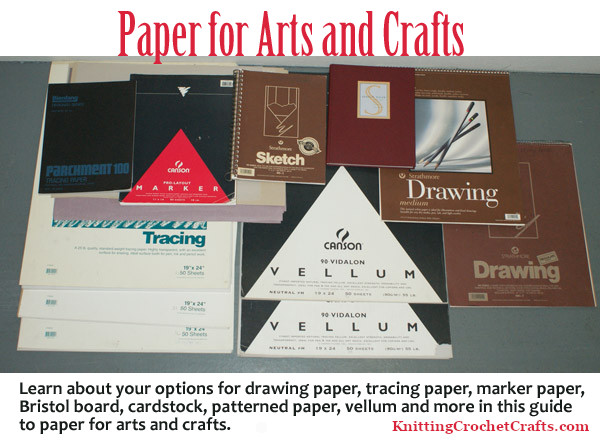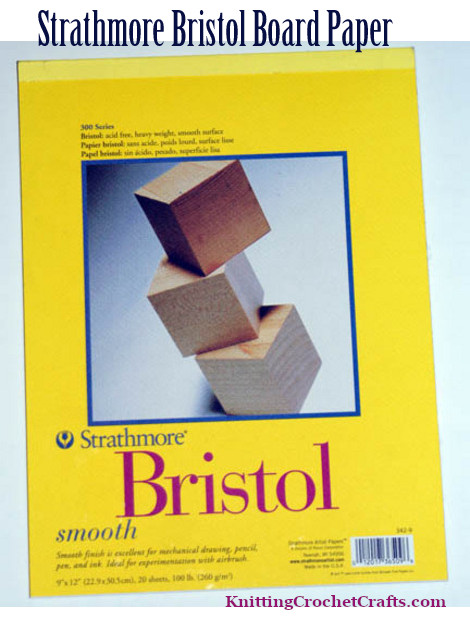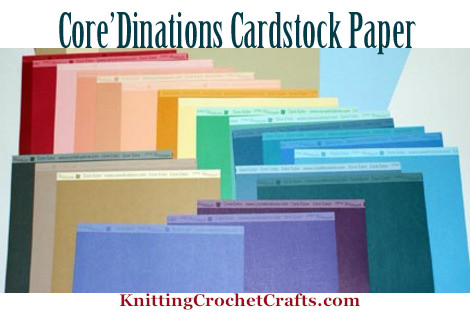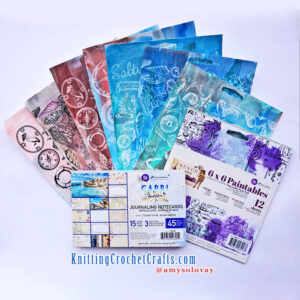
The Ultimate Guide to Choosing Paper for Arts and Crafts
There are zillions of different papers for arts and crafts. Nobody would blame you if you’re confused about which one to choose for the project you want to try next. That’s why I created this comprehensive guide to paper for arts and crafts.
Would you like guidance in understanding what makes one paper different from another? Or in understanding which paper brands make the best product for a particular purpose you have in mind?
I volunteer to help you with that.
Why should you care what I have to say on the topic of paper?
Well, because I’m both an artist and a crafter with extensive experience working in a broad variety of media. I hold a bachelor’s degree with a minor in studio art, and I also hold a separate degree in textile design. I have tried working with literally every type of art paper mentioned on this list — and I’ve enjoyed some successes with my art, while also having endured many failures.
I invite you to benefit from these experiences. I will do my best to guide you towards the paper that will be ideal for whatever type of art or craft project you have in mind.
I can’t claim to be successful at every possible type of art or craft you might be doing. However, I know enough to help steer you towards choosing a paper that is likely to work best for your intended purpose.
I’ve reviewed bunches of different artist papers and craft papers. I hope this guide, along with my product reviews, will help you save time and avoid the frustration that comes along with choosing the wrong paper for the task at hand (which I have done too many times to count).
For your convenience, I’ve alphabetized this list of paper for arts and crafts. Feel free to skip directly to the type of artist paper or craft paper that is of most interest to you.
Bristol Board, AKA Bristol Paper

Need an affordable, heavy paper for gouache painting, illustration, collage art, mixed media art, handmade greeting cards or other paper crafts? Want to use a paper that is stiff enough that it doesn’t require you to buy a separate mounting board for presentation? Strathmore Bristol board is exactly the paper you want for these purposes. It comes in two finishes: smooth (or “plate”) and vellum.
According to Strathmore’s website:
Bristol generally describes drawing paper that is pasted together to form multi-ply sheets. It derives its name from the early days of European papermaking when mills would send their finest paper to Bristol, England for pasting.
Learn more, plus find project ideas and examples, in my detailed product review of Strathmore Bristol Board.
Cardstock

Cardstock is useful for a broad variety of purposes ranging from business cards to book covers to handmade greeting cards to scrapbook layouts. I use this type of paper frequently in my art and craft projects. When it comes to cardstock, I have my favorite brands, but I’m not hugely brand loyal; I have experimented with using bunches of different cardstock brands. I share my thoughts about the best cardstock brands on my page about cardstock for arts and crafts.
Pictured above is Core’Dinations cardstock, which is my current favorite brand of cardstock paper for arts and crafts.
Construction Paper
Construction paper is a popular type of paper for kids’ crafts. It is a widely available and affordable type of paper that comes in a broad variety of colors. The colors tend to fade with time, and it is not typically acid free or archival quality — so it is not a good choice for art or craft projects to use for making projects that you want to last a long time. If you want to be able to keep your project (or your child’s project) for a long time, choose cardstock or scrapbooking paper instead of construction paper.
Copy Paper
Copy paper is a thin, flexible paper that is intended for use in copy machines. It is not typically intended to be archival quality, but it is possible to find high quality, acid-free copy papers. Copy paper varies widely in quality, so you will have to compare copy papers to find one that’s ideal for your intended purpose.
Copy paper is more of an office paper than an art paper, but it has its uses in art, too. Copy paper can be used as an alternative to newsprint for quick pencil sketches that are not intended to be permanent.
In one of my college-level art classes, our instructor had all of her students make a limited edition art book. She took us to the office to make photocopies of our drawings. We then exchanged copies and used them to create collages in our art books. I still have mine, 20+ years later, and the copy paper looks fine. It hasn’t yellowed substantially in the years since its original placement in the art book I made.
Crêpe Paper
Crêpe paper is a thin, crinkly-looking, textured tissue paper that is popular for use in making streamers, party decorations, paper flowers and similar types of projects. The crinkly appearance comes about because this type of paper has been coated with a glue-like substance known as “sizing”.
Crêpe paper is not typically archival quality, and should only be used in art or craft projects that are not intended to be permanent.
Illustration Board
Illustration board is a sturdy, stiff surface that doesn’t require a separate material for mounting. It is typically available in 2 different surfaces: vellum or plate (otherwise known as “smooth”). Illustration board is ideal for use with a variety of media; the media you use with it depends on which surface you select.
If you work in graphite pencil, colored pencil, marker or pen and ink, you could choose either vellum or smooth finish — whichever you happen to prefer. Both finishes are also suitable for collage art and mixed media.
If you work in charcoal, soft pastels, or oil pastels, choose the vellum finish.
Kraft Paper
Kraft paper is a sturdy, unbleached brown paper that is most frequently used as a packaging material. It also has its uses for arts and crafts. It can be transformed into gift tags, stationery, wrapping paper, greeting cards and a broad variety of other art and craft projects.
Mat Board / Mounting Board
Mat board is an ultra-heavy, stiff, inflexible paper-based material that is typically used in mounting and framing artwork. While framing artwork is its most obvious use, there are creative collage and mixed media artists who use mat board as their usual surface for creating art.
This makes sense if you are creating mixed media pieces with substantial weight. You can attach multiple layers and countless heavy materials to mat board without fear of it buckling or tearing. Many mat boards are acid free, which makes them more attractive as an archival-quality support than similar weight cardboard pieces, which tend to NOT be archival quality.
Marker Paper
Marker paper is usually thin, flexible and smooth and has a coating. The coating is specifically intended to prevent the ink from soaking into the paper. Instead, the ink remains on the surface of the paper, enabling you to blend it and create smooth transitions between colors. If you want to draw crisp, sharp lines that don’t bleed or run, marker paper is exactly the right surface to choose for that purpose.
Marker inks typically do not bleed through to the back when you work with good-quality marker paper. In contrast, markers do often bleed through when you use them on papers that are not specifically intended for use with markers.
Marker paper is a good investment if you’re hoping to use the least possible amount of ink when you create your artwork. If you want to maximize the useful lifespan of the markers in your art supply stash, marker paper is the ideal paper to work with.
Mulberry Paper
Mulberry paper is paper that is typically handmade from the bark of the mulberry tree (“kōzo” in Japanese). These papers hold a fold well, but the long mulberry bark fibers transform into a paper where the fold might not be as crisp as the fold you get with other types of papers.
Mulberry paper is suitable for a variety of uses. Use it for making paper flowers, greeting cards, paper lanterns, gift boxes, gift bags and scrapbook layouts.
Mulberry paper is frequently made in Asian countries including Japan, Thailand and China.
See Also: The entry for Washi paper below, as some (but not all) washi paper is made from paper mulberry / kozo fibers.
Newsprint
The word “newsprint” is almost self explanatory. This type of paper looks and feels similar to the newsprint that newspapers are typically printed on (except it doesn’t have the text). Newsprint paper has a rough, unfinished look and feel.
Newsprint is ideal for executing quick gesture drawings and warmup sketches. It’s also the type of paper you might want to reach for when you are sketching out rough ideas for drawings or illustrations that need significant planning. Newsprint is waayyyy more affordable than its more permanent counterparts; so if you plan to go through pages and pages of paper before you arrive at a final layout, using newsprint will save you a significant amount of money while you plan.
Origami Paper
Origami paper is manufactured with the specific purpose of being suitable for the Japanese art of paper folding. Origami comes in a broad variety of colors and patterns.
See also: The entry for Washi paper, below.
Patterned Paper / Scrapbooking Paper

Acid-free patterned paper is popular for making greeting cards, scrapbook pages and many other types of paper crafts. It is typically available in pads, packs and single sheets. The most popular pad and pack sizes are 12″x12″, 8 1/2″ x 11″, 8″x10″, 8″x8″, 6″x6″ and 4″x6″. These correspond to the most popular scrapbook sizes.
Pictured above are a couple of different pads of scrapbooking paper designed by Frank Garcia for Prima Marketing. One is the Printables travel / beach themed paper pad from the French Riviera collection by Frank Garcia; the other is a 4″x6″ pad featuring journaling card papers from the Capri Collection by Frank Garcia. It is typical for scrapbooking paper manufacturers to release themed collections of papers, stickers, and other supplies; these are some examples of travel, nautical, and beach- themed patterned scrapbooking papers; other popular themes include holidays / Christmas, birthday, floral, baby, school, and seasons of the year.
There are a couple of reasons you might want to choose scrapbooking papers instead of other sorts of papers. The first reason: Most scrapbooking papers are designed to be archival quality; they are typically acid free and lignin free, which means they are not prone to yellowing or browning, like other sorts of papers — particularly newsprint — are. (Copy paper is also likely to turn brownish or yellowish, but you can sometimes find acid free copy paper, so if that is important to you, be sure to check product descriptions. I sometimes use acid free copy paper in my stamping projects and planner layouts). You do need to be proactive about checking on the status if it is important to you to use archival quality papers, because not all scrapbooking papers are archival quality — but most are. However, you do pay for that; scrapbooking paper tends to be more expensive than many other types of paper, and the archival properties are one of the main drivers on higher prices.
The other differentiating factor with scrapbooking paper is the broad variety of colors and patterns you’ll find. If you want a colorful paper for any paper craft project you’re working on, scrapbooking paper is well worth checking out. There’s a dazzling variety of different designs available.
Tissue Paper
Tissue paper is a thin, flexible paper that is popular for use in giftwrap. You can also use it for making paper flowers, party decorations, streamers and similar crafts.
Tissue paper can also be useful as a packing material, for long-term storage of textiles or other items, or for displaying items for sale at retail. People stuff it inside shoes and handbags so these items keep their shape while being shipped, stored or offered for sale.
Tissue paper might or might not be archival quality. There are acid-free tissue papers available. If you want your project to be permanent, choose a neutral pH, unbuffered, acid-free tissue paper. Otherwise, standard tissue paper should only be used in art or craft projects that are not intended to be permanent.
Vellum
Historically, vellum was made from animal skin — usually calf, sheep or goat, but sometimes skin from other types of animals.
Today, the traditional type of vellum is not widely available, and you have to really go out of your way (and pay a substantial sum) to obtain it.
Today’s counterpart is a smooth, durable translucent paper that is typically made from either plasticized rag cotton or the fibers from interior tree bark.
Contemporary vellum is basically a high-quality tracing paper. Architects use it for making blueprints. Crafters use it for making a variety of paper craft projects including scrapbook layouts and embellishments.
Washi Paper
Washi paper is a type of paper that originates in Japan. It is typically made by hand in Japan according to traditional methods. The artisans who manufacture washi paper use local fiber including the inner bark of the gampi tree, the mitsumata shrub, or the paper mulberry bush. They follow the traditional Japanese process for making it.
Washi paper is typically used for a variety of purposes including origami and other crafts.
Washi paper comes in zillions of different colors and silkscreen prints. My sister lived in Japan for a couple of years, and she brought me some Japanese washi paper that had gorgeous flecks of metallic gold on its surface. Another pack of the washi paper she brought me had a colorful floral silkscreen print with metallic gold accents.
Watercolor Paper
Watercolor paper is a type of artist’s paper that is specifically intended for use with watercolor paints and similar water-based media such as watercolor crayons or gouache paints. The paper tends to be stiff and absorbent, making it less likely to buckle, ripple or warp than papers intended for other types of media — but this typically only holds true if the watercolor paper is prepared properly by soaking, stretching and drying prior to use.
When people discuss watercolor paper, a term that comes up often is “tooth”. When artists start talking about paper with a lot of “tooth”, they generally mean the paper has a lot of texture. Lovely watercolor paintings can result from using either smooth or textured papers; your personal preference is the most important factor. If you aren’t sure whether you prefer “toothy” watercolor papers or smooth ones, experiment with trying different papers until your own style and preferences emerge.
Professional-grade watercolor papers are often acid-free and made from 100% cotton rag fiber.
So there you have it: Those are your top choices for art and craft papers. I hope this information is helpful to you as you decide which paper to use for your next art or craft project. I welcome your questions about paper, or your additions to this page. Thanks so much for dropping by!
By Amy Solovay
About the Author: Amy Solovay is a freelance writer with a background in textile design. She holds a bachelor’s degree with a studio art minor; and she has also obtained another degree in textile design.
This page was last updated on 4-28-2023.